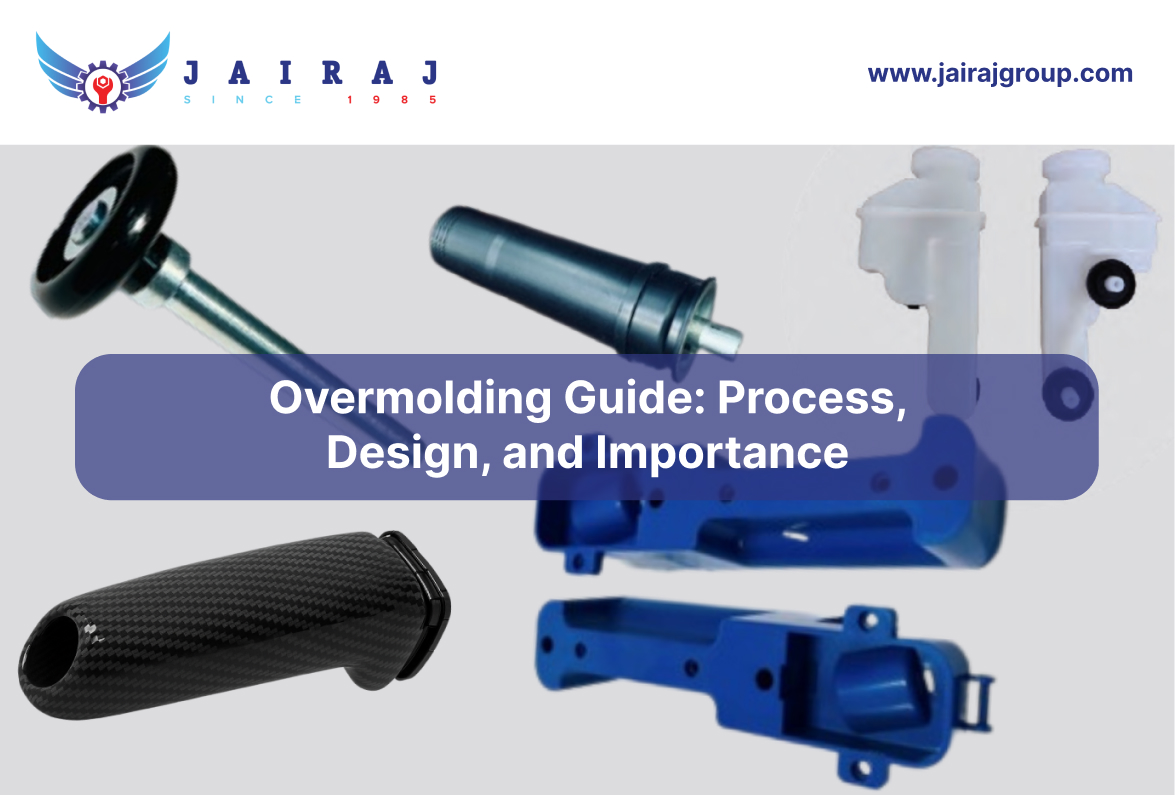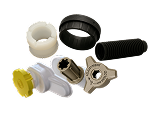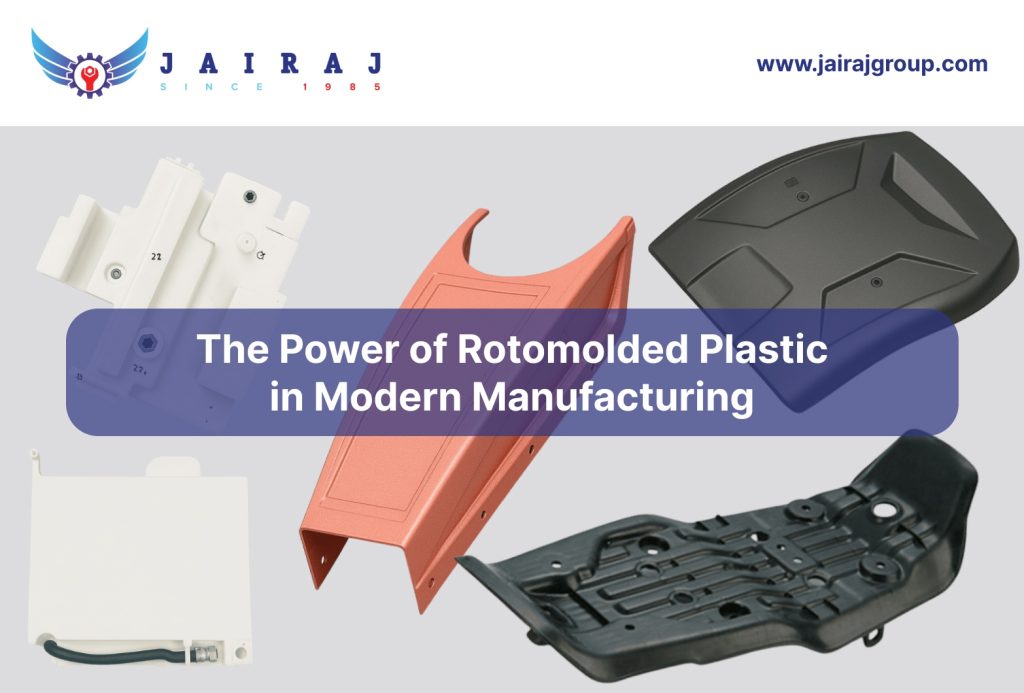Overmolding is a key process in modern manufacturing that enables multi-material components with superior functionality, ergonomics, and durability. Components such as hand grips, pedals, bellows, seating bases, and aerospace ducting benefit from the combination of material science, precise design, and advanced process engineering.
For OEMs, Tier-1 suppliers, and industrial manufacturers, overmolding extends beyond production. Material selection, mold design, and process optimization drive a large portion of program budgets.
This guide covers overmolding processes, design, materials, methods, benefits, challenges, and applications across key industries.
Key Takeaways:
Overmolding integrates multiple materials into a single component, combining structural strength with improved ergonomics, comfort, and durability.
It is widely used in automotive, EV, aerospace, defense, and industrial sectors to improve performance, reduce weight, and manage production costs.
Material compatibility, wall thickness, shrinkage control, and functional performance are critical design factors for achieving reliable overmolded parts.
Two-shot molding and other overmolding methods enable high-volume production with consistent quality and precise multi-material integration.
What is Overmolding?
Overmolding is an advanced injection molding process where a secondary material is molded over a primary substrate to create a single, unified component. Unlike conventional molding that uses a single material, overmolding allows the integration of multiple materials to deliver enhanced functionality, performance, and user experience.
Typical combinations include:
Rigid and soft polymers to balance structural strength with comfort.
Thermoplastics and elastomers for improved sealing, vibration absorption, and ergonomic surfaces
High-performance engineering plastics for structural and functional components in automotive, aerospace, and defense applications
For instance, hand grips for two- and three-wheelers combine a soft TPE over a rigid nylon base for enhanced ergonomics, while mobility seating solutions for compact EVs utilize overmolding to improve durability and user comfort.
Importance of Overmolding Process
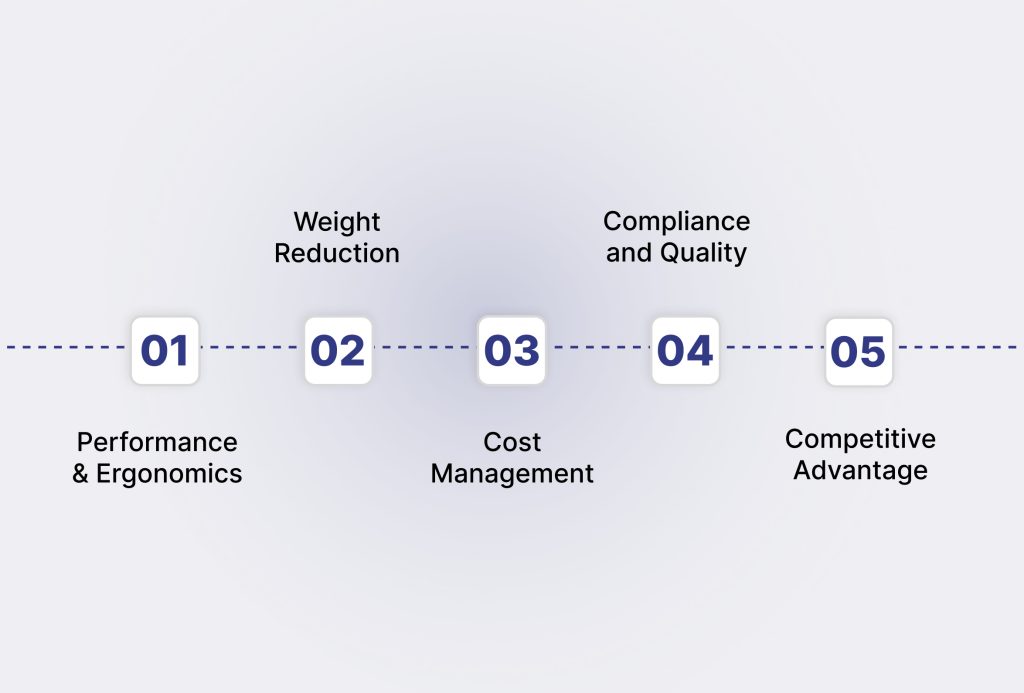
Overmolding is a strategic manufacturing approach across automotive, EVs, heavy machinery, aerospace, defense, and industrial sectors. It is not just a production method, it helps control costs, improve performance, and ensure program reliability.
Performance and Ergonomics integrates multiple materials in a single part for better grip, vibration damping, sealing, and comfort.
Weight Reduction replaces metals with engineered polymers to cut component weight by up to 30% while maintaining strength and durability.
Cost Management reduces part count and assembly complexity, enabling predictable production costs and flexibility with material selection.
Compliance and Quality supports strict standards like IATF 16949, FST, and PPAP through precise material selection, mold design, and process control.
Competitive Advantage enables soft-touch surfaces, multi-material integration, and two-shot molding, enhancing ergonomics, aesthetics, and NVH performance.
For executives, overmolding is about combining design, material, and production strategy to manage cost, reduce supply risk, and maintain program timelines.
Overmolding vs Insert Molding: Key Differences
While both overmolding and insert molding involve combining materials into a single component, they differ in purpose, process, and applications.
Understanding these differences helps OEMs and Tier-1 suppliers select the right approach for performance, cost, and manufacturing efficiency.
| Aspect | Overmolding | Insert Molding |
|---|---|---|
| Definition | Secondary material is molded over a primary plastic substrate | Molten plastic is injected around a pre-placed insert (metal, plastic, or ceramic) |
| Primary Purpose | Improves ergonomics, aesthetics, and functionality | Adds structural strength, conductivity, or threaded features |
| Materials Used | Typically plastics, elastomers, or engineering polymers | Inserts can be metal, ceramic, or pre-formed plastic with plastic overmold |
| Applications | Hand grips, pedals, seals, dashboards, medical handles | Electrical connectors, threaded fasteners, structural reinforcements |
| Key Advantages | Better grip, vibration damping, sealing, noise reduction, soft-touch feel | Stronger mechanical performance, conductivity, fewer secondary assembly steps |
| Best For | Multi-material integration and user comfort | Durability, structural reinforcement, and precision inserts |
Design Considerations in Overmolding: Engineering for Reliability and Scale
Successful overmolded parts are designed by carefully balancing mechanical, thermal, and chemical factors, ensuring they meet manufacturing, compliance, and operational requirements for OEMs and Tier-1 suppliers.
Four primary considerations guide this process:
1. Material Compatibility: Building a Strong Bond
Why it matters: Adhesion failures are one of the most common causes of rejected parts and field returns.
Design focus areas:
- Substrate and overmold materials must align in terms of surface energy, thermal expansion, and chemical bonding.
- Engineering plastics such as glass-filled Nylon 66 provide rigidity, while elastomers like TPE deliver grip, vibration control, and comfort.
- Adhesion testing should be conducted before production tooling is approved.
Example: Two-wheeler grips combine a rigid nylon base with a soft TPE overmold, ensuring durability and comfort during long-term use.
2. Wall Thickness and Flow Control: Ensuring Structural Integrity
Why it matters: Inconsistent wall sections can cause warpage, sink marks, and premature failure.
Design focus areas:
Uniform wall thickness reduces internal stress during cooling.
Gate placement, runner design, and injection strategy must be optimized for balanced flow. This is critical in visible parts such as interior trims and in safety-related systems such as brake pedals.
Simulation tools should be applied during design to predict flow paths and identify weak points.
3. Shrinkage and Tolerances: Maintaining Dimensional Precision
Why it matters: Substrate and overmold materials shrink at different rates, which can compromise assembly fit and stability.
Design focus areas:
Design must account for differential shrinkage, particularly in glass-reinforced polymers compared with soft elastomers.
Tolerance control is essential to meet PPAP requirements and aerospace or defense standards.
Components such as ducts for aerospace or EV seating systems require CAD and tooling adjustments to compensate for shrinkage.
4. Functional Performance: Meeting Operational Demands
Why it matters: Overmolding should not only improve appearance but also deliver measurable performance benefits.
Design focus areas:
Define clear functional goals such as vibration control, tactile feel, thermal resistance, or chemical stability.
Overmold thickness must balance flexibility with structural support.
Long-life parts like plastic bellows require flexibility and fatigue resistance across thousands of operating cycles.
4 Common Methods of Overmolding
Overmolding can be carried out through different manufacturing methods, each with unique strengths. Choosing the right approach depends on part geometry, production volume, and application requirements.
1. Two-Shot Molding
This process uses a single mold with two injection nozzles to sequentially inject different materials. It is efficient for high-volume production where consistency is critical.
Example: Widely used for brake pedals, EV seating bases, and automotive interior trims.
2. Pick-and-Place Molding
Here, the substrate is molded first and then inserted manually or with a robot into another mold for overmolding. This method is flexible and works well for complex or multi-substrate designs in medium production runs.
Example: Common in aerospace ducts, defense-grade components, and intricate EV connectors.
3. Rotational Overmolding
In this method, the substrate rotates while the secondary material coats it, creating an even distribution. It is suitable for large or hollow components that need durable protection.
Example: Applied in roto-molded panels for heavy equipment and protective earth mover housings.
4. Core-Back Molding
Movable cores inside the mold allow secondary materials to flow into precise cavities, enabling complex geometries. This method supports integration of multiple materials with high accuracy.
Example: Used in structural automotive components, high-performance housings, and dual-layer ducts.
Overmolding Process: 4 Stages for Successful Results
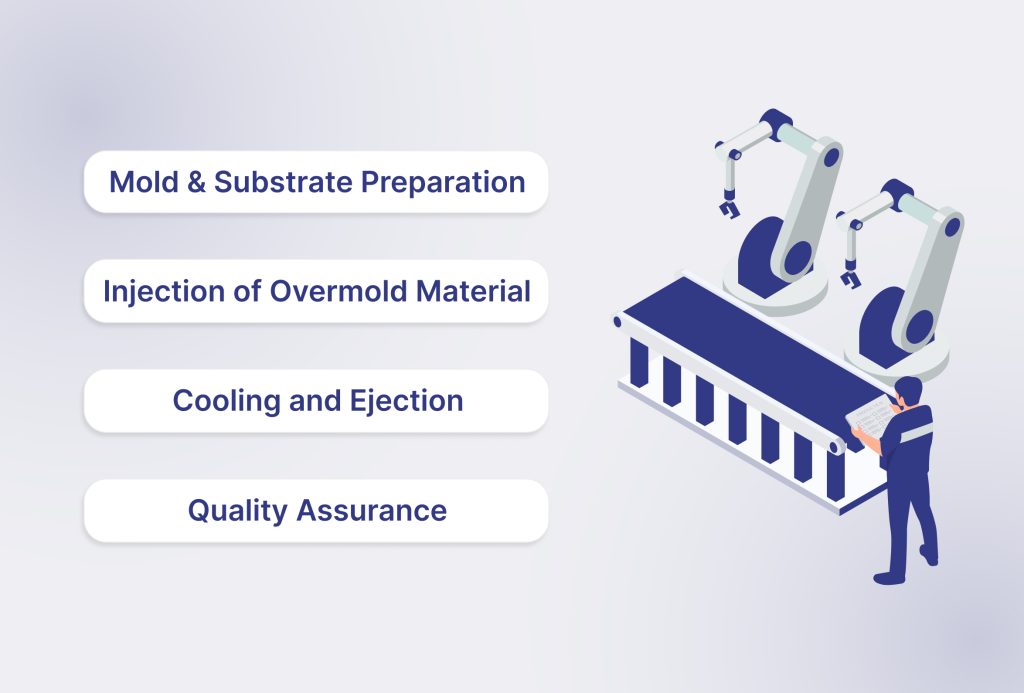
For OEMs, Tier-1 suppliers, and industrial manufacturers, overmolding is not just a technical process but a performance and cost-control lever. Success depends on how well materials bond, how molds are engineered, and how tightly process variables are managed.
Four stages define the difference between parts that fail validation and those that consistently meet program expectations.
1. Mold and Substrate Preparation
Why it matters: Poor preparation leads to weak adhesion, dimensional distortion, and costly rework.
Execution priorities:
Mold design must account for material flow, thermal expansion, and surface textures that promote bonding.
Substrate components such as brake pedals, shock absorbers, or panels are cleaned, preheated, and accurately positioned to eliminate surface contamination.
Early alignment of design and process ensures that substrates can withstand the stress of overmolding without compromising performance.
2. Injection of Overmold Material
Why it matters: The injection stage determines how well the secondary material bonds and whether the component achieves its intended functionality.
Execution priorities:
Elastomers such as TPE, TPU, or Hytrel are injected over the substrate.
Process variables like temperature, pressure, and injection speed are tuned to the material’s rheology to prevent defects like voids, warpage, or delamination.
Correct gate placement and balanced flow paths reduce cosmetic defects and stress concentrations.
3. Cooling and Ejection
Why it matters: Improper cooling introduces residual stresses that compromise part performance in real-world use.
Execution priorities:
Cooling rates are tightly controlled to maintain dimensional accuracy and material bonding.
Post-processing steps such as trimming, machining, or surface finishing are applied where functional or aesthetic requirements demand it.
For high-load parts, such as roto-molded earth mover panels, precision in this stage ensures performance under extreme operating conditions.
4. Quality Assurance
Why it matters: Components must not only perform but also pass compliance gates such as IATF 16949, PPAP, or aerospace/defense audits.
Execution priorities:
Non-destructive testing validates adhesion strength and structural integrity.
Precision inspection confirms dimensional accuracy against CAD and tolerance specifications.
Rigorous validation simulates operational stresses to ensure that parts perform reliably in production environments.
Also Read: Plastic Injection Molding: Precision Thermoplastic Components
How To Select Material for Overmolding?
Material choice is the single most critical decision in overmolding. It determines not only how well the overmold bonds to the substrate but also how the part performs across its service life.
Here are the core factors that guide this decision.
- Adhesion and Bonding: Strong adhesion prevents delamination under vibration, load, or environmental stress. Compatible melt temperatures, surface treatments, and humidity/thermal cycle testing are essential to validate reliability.
- Hardness and Flexibility: Shore hardness of elastomers must balance with substrate rigidity to ensure comfort, grip, and vibration absorption. Flexibility is especially important in bellows, lever covers, and seating systems.
- Thermal and Chemical Resistance: Elastomers must withstand oils, coolants, solvents, and elevated temperatures. Materials like Nylon 66 GF or PBT Arnite provide durability, while thermal cycling tests confirm long-term stability.
- Mechanical Strength: Tensile, flexural, and compression properties must meet operational loads. Reinforced substrates such as glass-filled nylons or PC/ABS blends deliver stiffness and fatigue resistance for load-bearing parts.
Check out the key common material for the overmolding process:
| Overmold Material | Substrate | Typical Applications |
|---|---|---|
| TPE / TPV | Nylon 6 / 66 GF | Hand grips, bellows, pedal covers |
| TPU / Hytrel | PBT Arnite | Rebound bumpers, damper bushes |
| Polycarbonate | ABS / PC | Interior trims, display housings |
| PP / TPE | Nylon | Footrests, lever covers, EV seating bases |
These pairings illustrate how elastomers provide comfort, damping, or flexibility, while engineering substrates deliver structural performance.
Industrial Benefits and Challenges of Overmolding
Overmolding enhances ergonomics, reduces vibration, and allows design flexibility, while also cutting down on assembly steps and production time. However, achieving these benefits requires precise material compatibility, mold design expertise, and process control.
The table below highlights the key advantages and disadvantages of overmolding for industrial applications:
| Advantages | Disadvantages |
|---|---|
| Enhanced ergonomics and grip (grips, pedals, seating solutions) | Bonding failures caused by contamination or incompatible materials |
| Vibration and noise reduction in automotive and heavy machinery | Warping and residual stress from mismatched thermal expansion or shrinkage |
| Improved sealing and structural protection for EVs and appliances | Complex mold design and higher maintenance requirements |
| Aesthetic versatility with multi-color or textured finishes | Precise process control required for consistent quality |
Applications of Overmolding Across Industries
Overmolding delivers multi-material components that meet demanding performance, aesthetic, and safety requirements across industries. Its adaptability allows manufacturers to optimize ergonomics, durability, and functionality in a single part.
Key applications include:
- Automotive and EVs: Pedals, hand grips, dashboards, seating bases, interior trims, and exterior panels for enhanced comfort, NVH performance, and safety
- Heavy Equipment and Earth Movers: Bellows, struts, protective panels, canopies, and covers designed for rugged environments and high operational loads
- White Goods and Appliances: Panels, knobs, trims, and functional covers offering durability, chemical resistance, and aesthetic appeal
- Defense: Military-grade polymer components for vehicles, UAVs, and tactical systems requiring structural strength and reliability
- Aerospace: Lightweight, FST-compliant interior and structural components ensuring safety and efficiency
- Railways, Solar, Drones, and Industrial Equipment: Precision-engineered polymer parts optimized for performance, vibration resistance, and long service life.
Also read: Automotive Interior & Exterior Plastic Parts Manufacturing: Trends and Innovations in 2025
Overmolding Solutions for OEMs and Tier-1 Manufacturers
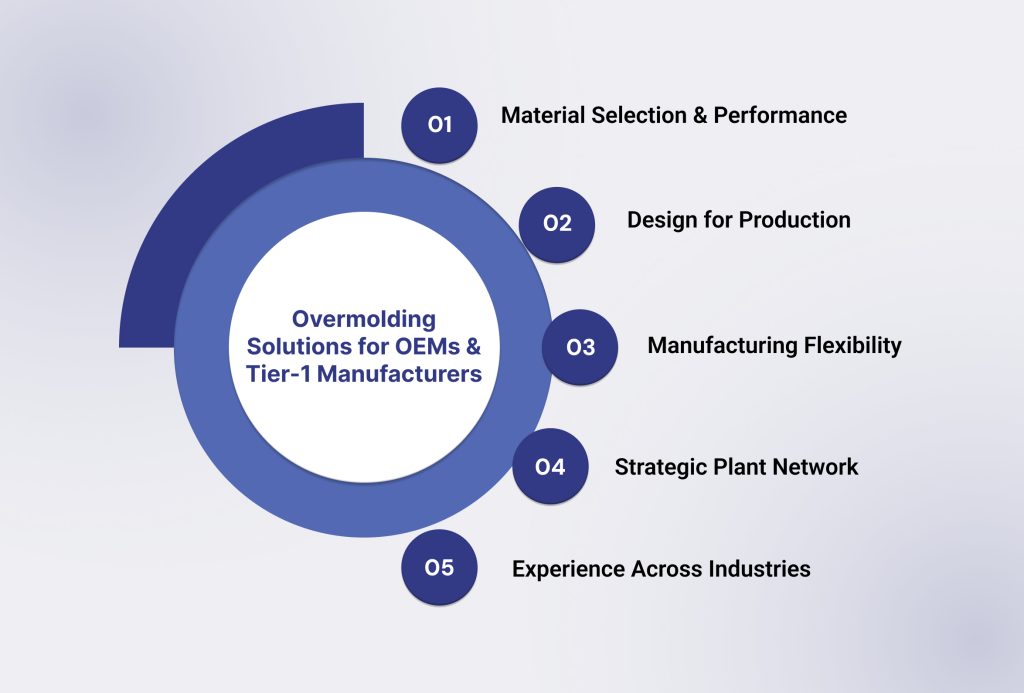
For OEMs and Tier-1 suppliers, smooth program execution and on-time production depend on overmolding expertise. The right partner delivers high-performance components, manages total cost of ownership, strengthens supply chains, and ensures audit readiness.
JaiRaj Group has developed overmolding capabilities focused on the key factors that influence advanced component manufacturing:
1) Material Selection and Performance
JaiRaj works with TPEs, TPU, Nylon, PBT, PC, ABS, and advanced polymer blends to optimize grip, sealing, vibration resistance, and multi-material integration. In-house R&D enables rapid material validation and substitution, giving manufacturers flexibility in changing market conditions.
2) Design for Production
The team engages early in design reviews to ensure proper wall thickness, gate placement, and shrinkage management. Simulation-supported design practices reduce defects, speed up validation, and ensure consistent large-scale production.
3) Manufacturing Flexibility
JaiRaj provides multiple overmolding options under one roof, including two-shot molding, pick-and-place techniques, rotational, blow, and injection molding. This variety allows manufacturers to select the best process for each component, such as hand grips, vibration-absorbing bellows, or multi-material seating bases.
4) Strategic Plant Network
Facilities in Faridabad, Manesar, Aurangabad, Sanand, and Rudrapur are positioned near major automotive and industrial hubs. This network shortens lead times, reduces logistics costs, and provides backup capacity to maintain production continuity during disruptions.
5) Experience Across Industries
With over 35 years of experience and certifications including ISO, IATF 16949, and CE, JaiRaj delivers reliable solutions for complex programs. Its overmolding portfolio includes:
Hand Grips and Pedals
Mobility Seating Solutions
Bellows and Struts for Vibration Absorption
Interior and Exterior Automotive Components
Roto-Molded Panels and Industrial Parts
Aerospace and Defense Components
For procurement and program managers, JaiRaj provides more than components. It delivers a partnership focused on performance, cost efficiency, and program reliability.
Conclusion
Overmolding plays a key role in modern component manufacturing. It impacts not only product functionality but also production efficiency, durability, and overall cost management.
Companies that combine careful material selection, optimized mold design, precise process control, and experienced supplier collaboration achieve three consistent benefits:
Improved product performance with better ergonomics, vibration reduction, sealing, and integration of multiple materials.
Streamlined production by minimizing assembly steps and ensuring consistent, high-quality output.
Controlled costs through reduced scrap, lower rework, and more predictable lifecycle expenses in high-volume production.
For manufacturers creating mobility seating solutions, hand grips, heavy vehicle panels, or aerospace ducts, working with a skilled overmolding partner like Jairaj Group ensures dependable quality, compliance, and long-term performance.
Reach out to Jairaj Group for a Design for Manufacturability (DfM) review or to visit facilities in Manesar, Sanand, or Aurangabad.
Contact JaiRaj Group to discuss your project requirements.
FAQs
1. What factors influence the cost of overmolded components?
Cost depends on tooling complexity, substrate and overmold material selection, part geometry, and production volume. High-precision molds and specialized materials increase upfront costs, while cycle time affects per-unit pricing.
2. How does mold design impact production timelines?
Poor mold design can cause delamination, warping, or air traps, requiring rework and delaying production. Early DfM reviews and process optimization ensure faster validation and on-time launches.
3. When should specialized overmolding processes be used?
Two-shot, core-back, or rotational overmolding are ideal when they enhance performance, aesthetics, reduce assembly, or meet regulatory standards, e.g., soft-touch grips on rigid pedals or large hollow earth mover panels.
4. What should OEMs look for in an overmolding supplier?
Look for certifications (ISO 9001, ISO 14001, IATF 16949), in-house R&D, tooling expertise, multi-plant capability, and proven multi-material production experience for reliable, high-quality components.
5. How does material compatibility affect performance?
Compatibility affects adhesion, durability, and functionality. Thermal expansion, surface energy, hardness, and chemical resistance must align. For example, TPE over nylon ensures grip and vibration damping.
6. What are the main challenges in overmolding?
Challenges include bonding failures, warping, and cycle variations. Mitigation requires correct material pairing, precise mold design, process control, and supplier expertise.

